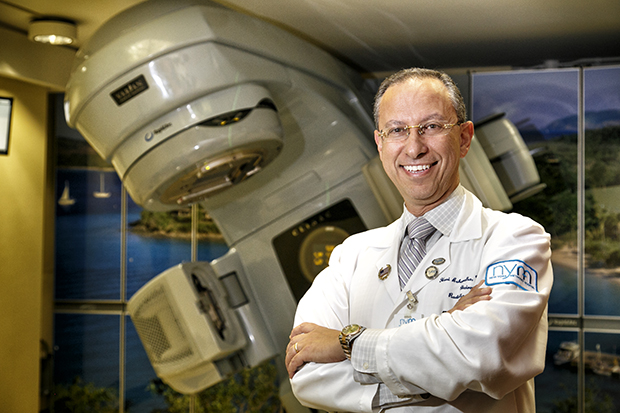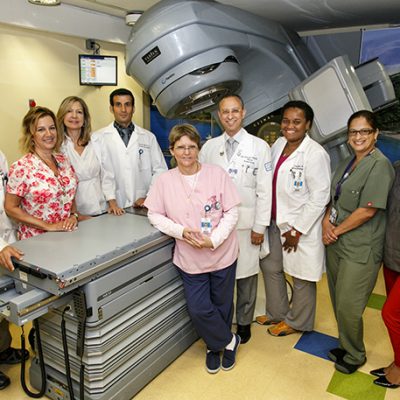
IN THE FIGHT AGAINST CANCER, NEW YORK METHODIST HOSPITAL’S RADIATION ONCOLOGY PROGRAM HOLDS THE HIGH GROUND IN STAFF EXPERTISE AND THE LATEST TECHNIQUES
BY MEGAN SCHADE • PHOTOS BY AMESSÉ PHOTOGRAPHY
The Department of Radiation Oncology at New York Methodist Hospital is much like a command center in the war against cancer. Each cancer calls for a battle. Every treatment plan requires a uniquely crafted strategy, with weapons that include radioactive ammunition, cutting-edge artillery, and four-dimensional coordinates that show the tumor in the crosshairs. Hani Ashamalla, M.D, chairman of radiation oncology at New York Methodist Hospital, is the five-star general on the front lines, leading his loyal troops. And while Dr. Ashamalla, who has research published in international journals and renowned clinical expertise, could wear his rank with pride, he prefers to defer to the power of his team.
“We come as a unit,” said Dr. Ashamalla. “I am extremely fortunate to be surrounded with such a wealth of talent, and I am honored to work with each and every member of radiation oncology team here at NYM. Sameer Rafla, M.D., my predecessor, was chairman of this department for 40 years. He remains a vital member of the radiation oncology faculty, which also includes Bahaa Mokhtar, M.D., Kapila Parikh, M.D., Monzer Tchelebi, M.D., and Eva Katsoulakis, M.D. Our lead physicist, Nnaemeka Ikora, M.D., oversees the physics section and leads a group of experienced physicists and dosimetrists who generate the appropriate plan of radiation to treat a cancer. And then there is the group of unparalleled radiation therapists, led by Pamela Ross, R.T.T., who operate the technology that delivers the therapy.
In addition, the fact that we are a teaching hospital with a top-notch radiation oncology residency program means that we have a corps of bright young doctors who swell the ranks of our attending physicians.” After completing his medical education in Egypt, Dr. Ashamalla came to the United States, and to Brooklyn’s New York Methodist Hospital. “I had originally planned to go into pulmonology, but in studying the lungs, I was increasingly fascinated with the possibilities for treating cancer,” Dr. Ashamalla said. After completing a residency in radiation oncology, he stayed on at New York Methodist, and in 2010, he became chairman of the department. “One thing that has always defined cancer management at NYM is the interdepartmental collaboration,” said Dr. Ashamalla.
Cancer treatment often includes a combination of radiation therapy, chemotherapy, and surgery. Rarely is a cancer treated with just one modality, and each treatment plan is as unique as the patient. To that end, each patient’s case is reviewed by a multidisciplinary panel of medical experts who develop the best treatment plan for that individual patient. “For example, for our lung cancer patients, the Comprehensive Lung Cancer Center is staffed with a core group of physicians—radiation and medical oncologists, thoracic surgeons, Pulmonologists, interventional Pulmonologists, and interventional radiologists, who meet on a bi-weekly basis to review all new cases and discuss all of the possible treatment options. The result is an efficient, well-coordinated plan of care, tailored to each patient,” explained Dr. Ashamalla. Radiation oncology refers to a type of cancer treatment modality that uses doses of high-energy radioactive particles to damage the DNA of cancerous cells. A cell with damaged DNA cannot replicate and dies. Radiation may be delivered to the cancerous tumor either externally, through carefully targeted rays, internally, through radioactive implants. External radiation uses high-energy beams, like x-rays, gamma rays, or electron beams, to target the cancer.
“One of the greatest challenges in external radiation is the need to ensure that all of the cancerous tissue is reached but also that, to the greatest extent possible, non-cancerous tissue is spared, especially in hard-to-reach places or tissue next to vital organs,” said Dr. Ashamalla. “At NYM, we have the most advanced technologies available to help us meet that challenge. We have an extremely efficient department with a level of advanced radiation oncology technology that rivals any major teaching hospital in the country.” “For instance,” added Dr. Ashamalla, “stereotactic radiotherapy is a highly precise form of external radiation therapy that has been is use for years to treat cancers and other abnormalities of the brain. Now radio surgery is also being used to treat cancer in other parts of the body in a procedure called stereotactic body radiotherapy. Using three-dimensional imaging to assess the tumor, beams of radiation are aimed to converge on the target area from different angles and planes. The radiation is delivered using a linear accelerator. Stereotactic therapies offer highly accurate delivery, which is especially important for cancers in hard-to-reach places.”In discussing another form of external radiation,Dr. Ashamalla pointed to a recent case where “we treated a patient with a rare lung cancer. Lung cancers can be tricky to target because the breathing motion means that the tumor is in an almost constant state of movement. But, using a combination of respiratory gating therapy, which accommodates for breathing movement, and intensity modulated radiation therapy (IMRT), which emits beams three-dimensionally, we were able to deliver the radiation with incredible precision.”
Some cancers, such as prostate, breast, cervical, and skin cancers, respond well to internal radiation therapy. Unlike external therapy, in which high-energy beams are directed at the tumor from outside the body, internal therapy involves placing a radioactive material directly inside or next to the tumor. A process called brachytherapy is a popular and effective internal radiation treatment for some cancers, and can be inserted temporarily or permanently. For prostate cancer, temporary brachytherapy involves placing radioactive wires in the prostate for short periods over the course of treatment. Permanent therapy requires placing radioactive seeds in the prostate gland, where they slowly release radiation as they ultimately decay. “For some breast cancer patients, we are able to offer a type of brachytherapy called MammoSite,” said Dr. Ashamalla’s colleague and mentor, Dr. Rafla, who has worked extensively in breast cancer prevention and treatment. Sometimes called balloon catheter radiation, MammoSite treatment consists of a thin tube with a balloon-like sac, which is placed near the cancerous tissue. A radioactive “seed” is inserted through the catheter and rests in the balloon, where it emits the curative radiation to the affected tissue. At the end of each session, the catheter and balloon are extracted, removing the seed with it. The radioactive particles are not staying in the body. “The benefit of Mammosite is that the treatment is greatly accelerated, with just two thirtyminute outpatient sessions over one week instead of six weeks of external radiation therapy.”“Another internal radiation therapy that we actually developed here at NYM is vertebral intracavitary cement and samarium (VICS),” said Dr, Ashamalla. VICS is an innovative treatment for cancer in the spine that consists of mixing samarium, a radioactive material that kills cancer cells, with a cement-like material, and injecting the mixture into the affected area, eliminating the need for open spinal surgery. ”The VICS procedure is attractive because it is minimally invasive, and achieves many goals of a traditional open surgery procedure with significantly less risk. Most patients feel immediate pain relief and return home the same day,” said Dr. Ashamalla.
“I am extremely proud of this department,” Dr. Ashamalla added. “Yes, the talent of the staff is prodigious, but it is our ability to help people and our success in doing so that make me proud. Cancer treatment can be a scary time for patients, but they know that when they come here, they will be receiving individualized treatment at highest quality of care. Essentially, that we will be taking excellent care of them.”





